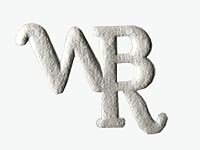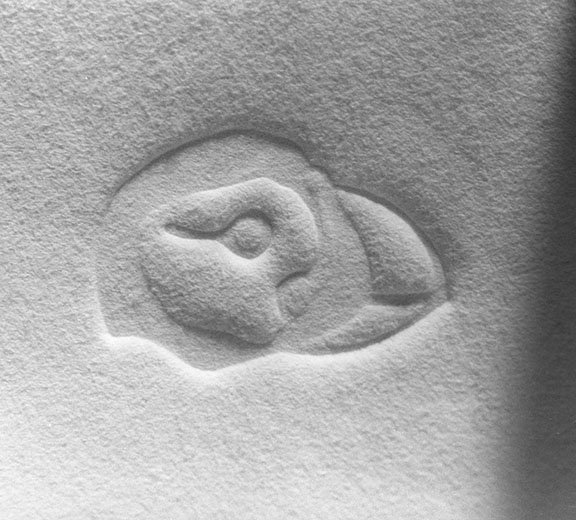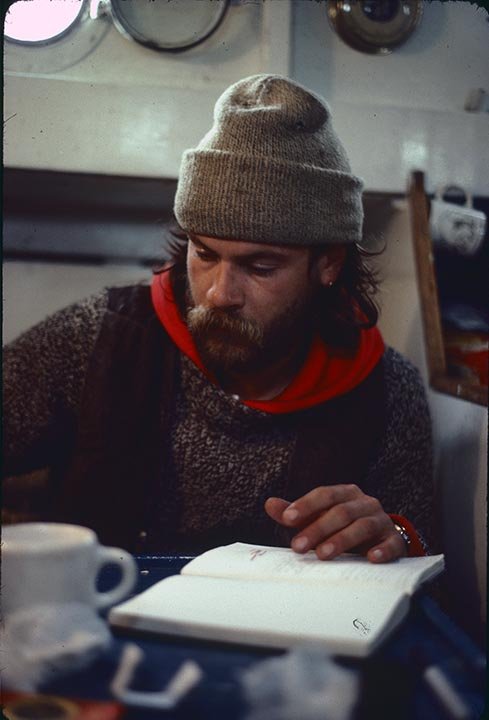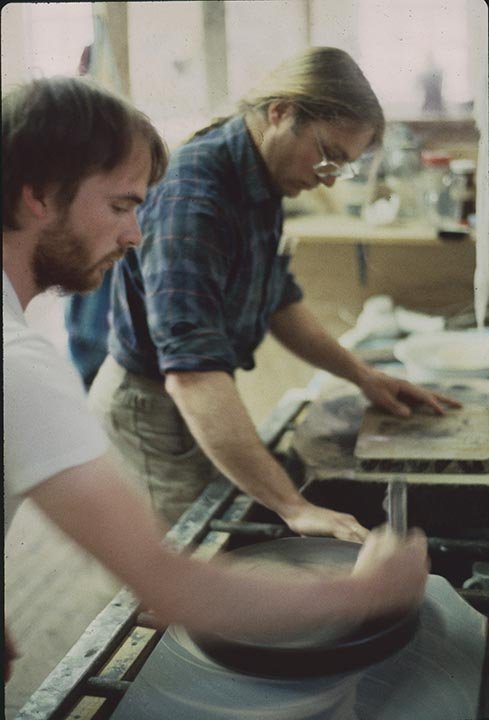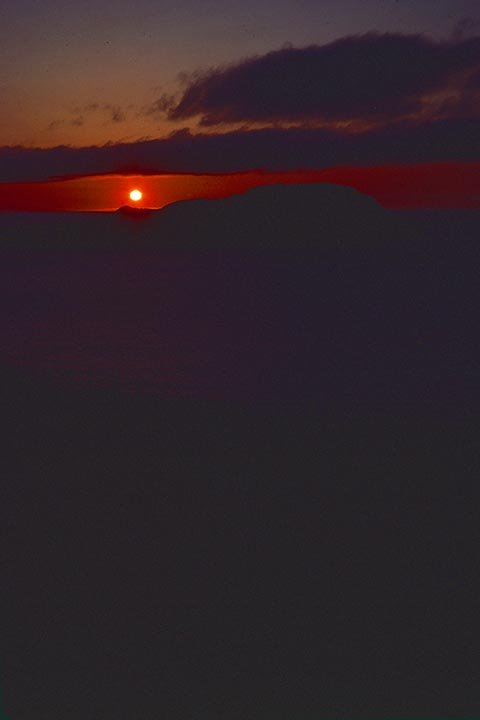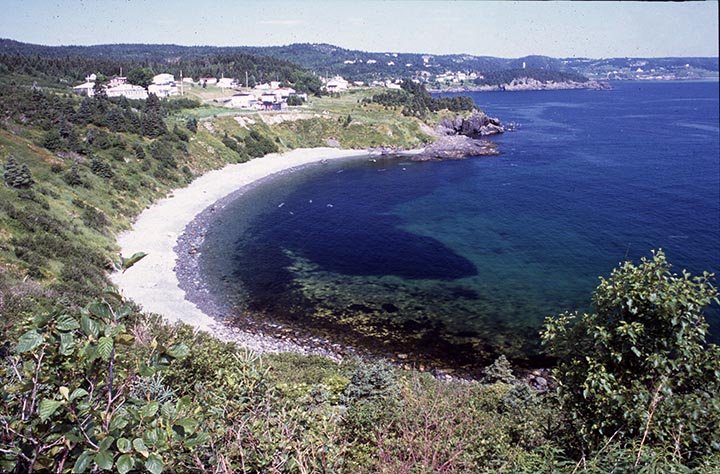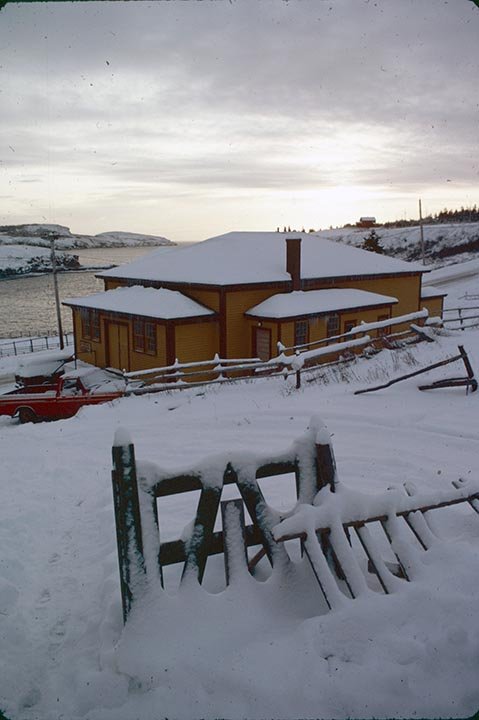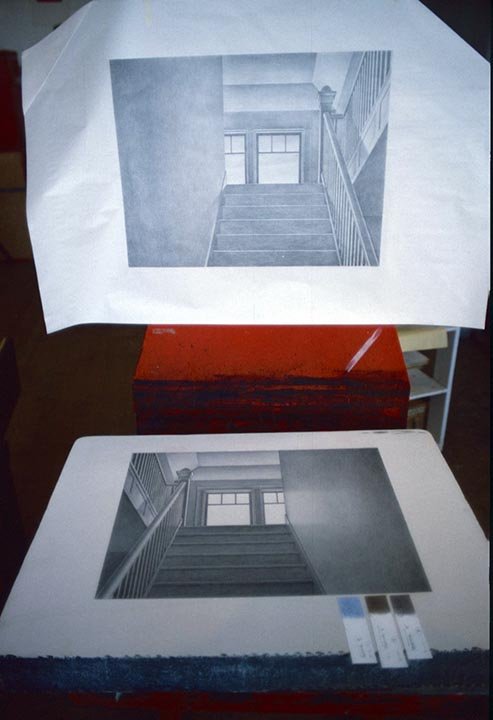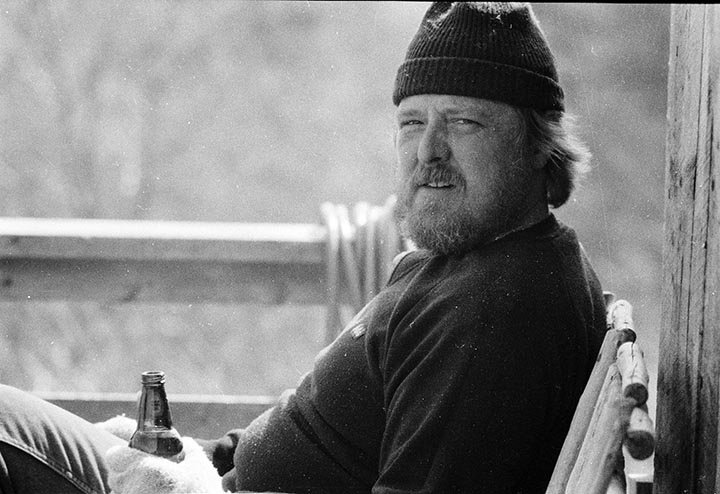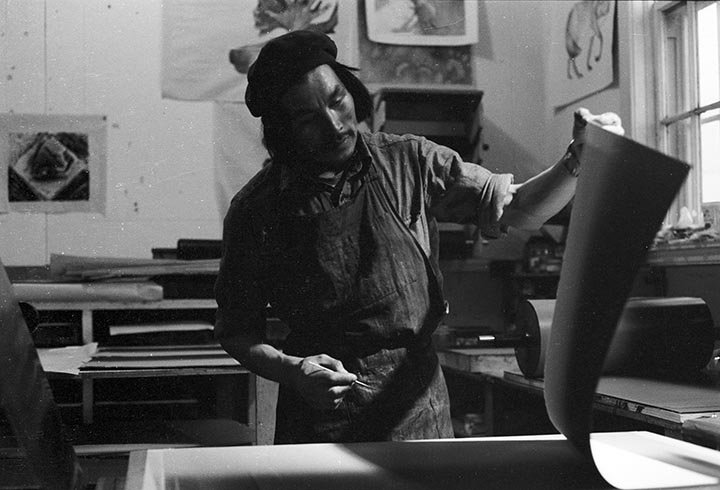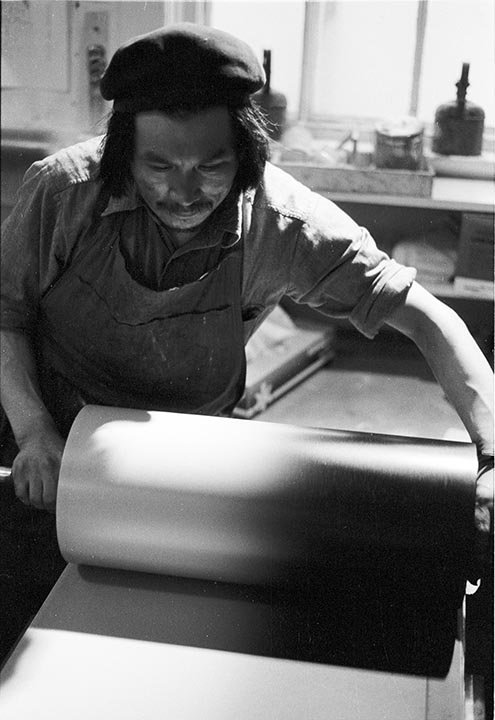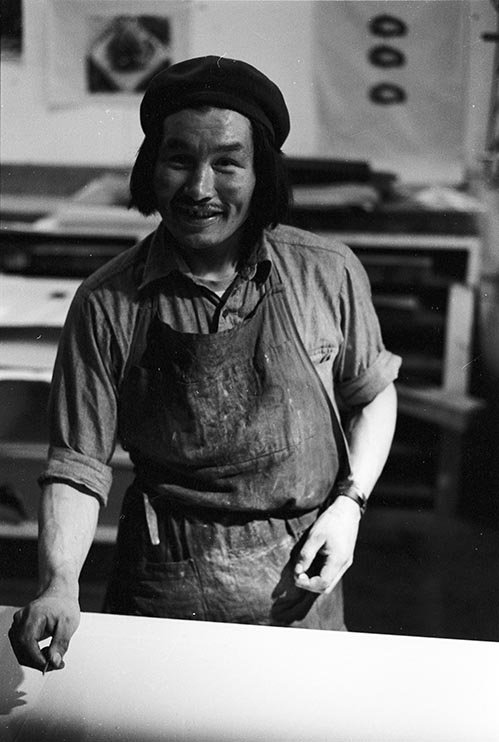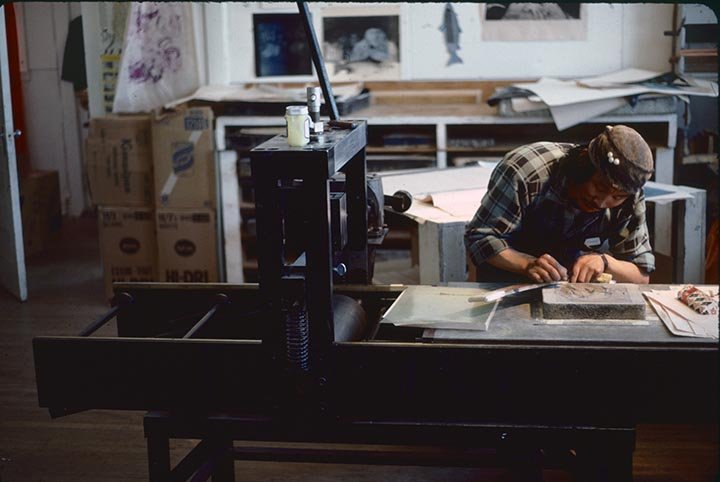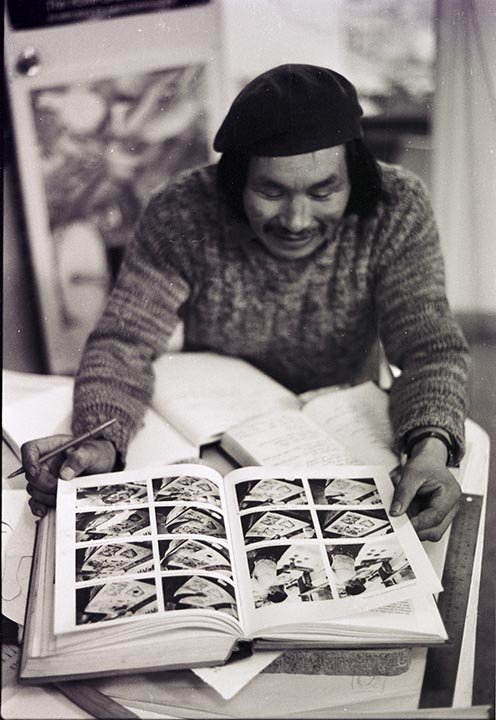St.Michael's Printshop
The paper chop that accompanies every printed impression produced at St.Michael’s Printshop
The formative years
When I left the Nova Scotia College of Art and Design in Halifax (1976), I did so to travel to Nain, Labrador. Memorial University of Newfoundland (MUN) offered an Artists in the Community Program and with the help of the NSCAD out reach officer, Patty Ivory, I applied to travel to Nain - as far north as I could go in Newfoundland at that time. It wasn’t so easy as Memorial University didn’t have an out reach officer in Nain, but Leo Hannerhan in Happy Valley, Goose Bay said he could be the contact person. I would report to him.
The only photo I have of myself while at NSCAD in my studio, 1975.
Let me digress. According to my journals George Swinton had been invited to NSCAD to give a talk about Inuit art and Shamanism. After his talk he visited me in my studio and suggested that I might be a good candidate to go to Clyde River to help out in their screen printing workshop. He liked my work and was especially fond of a series I was working that were zerox multiple over printings of a bear skulls and human faces. He asked if he could have one and I explained that these were unresolved so thank you no. I wrote to him but I never did hear back from him, I probably should have given him the zerox transformation image I guess?
I never heard from George again, but he planted a seed in my brain and I began to investigate further. There were a number of print shops in the Canadian Arctic. Who knew? I went to see Patty Ivory. She discovered MUN’s Artist in the Community Program and I thought that it could be a start to moving in a northern trajectory.
During my time at NSCAD there was definitely an interest in indigenous consciousness. Eric Fischl was my painting instructor at the time and he was interest in artist as shaman.Arts Canada Magazine had a huge publication called Stones bones and skin, I discovered older links to Mircea Eliade, Claude Lévi-Strauss and my all time favorite artist was Joseph Beuys’ who was the guest lecturer at our graduation, heady times.
All this just to illustrate how my mind was fueled in these early days, soon to be tempered by a healthy dose of reality.
While I waited for the William Carson to sail north from Lewisport, NL, I was billeted with Julie Windebank for a week or so. It was the start of a friendship that lasts to this day.. Mena Hickey at MUN’s Extension Services put together the supplies that were to last me for a month as I worked with children in the northern community.
In the meantime, a field trip was arranged to check out a relatively new print shop in the small fishing community of St.Michael’s on Newfoundland’s southern Avalon. It was run by Memorial University at the time. Hiedi Oberheide and Don Wright met us and showed us around the studios that were intended to bring local artist/print makers and print makers from around the world together to share and learn from one another. Little did I know at the time that years later, this print shop would be my re-entry point back into the southern art scene.
I boarded the William Carson and we steamed our way to Goose Bay through gales and pack ice. Less than a year later, the Carson would find herself on the ocean floor after a too-close encounter with an iceberg.
The bell of Bonavista.
I met Leo Hannerhan and he briefed me on what to expect in Nain. Room and board were arranged with Henry Voisey who would meet me at the wharf when the Bonavista docked in a weeks time, he did.
photo: Stephen Loring. Aboard the Tunniyak keep up with my journal writing.
1981
I decided to stay in Nain but that is another story.
I had applied for a Newfoundland and Labrador Arts Coucil gratn for my friend Gilbert Hay and myself to make lithographs and illustrate Inuit folk stories that were to be published in a book at some time in the future. Gilbert hadn’t made prints before but I was sure that he would figure it out in no time and he did. I had almost all but forgotten my years of printmaking training so Don Wright patiently over saw ever step of the process with the both of us. I believe we were there for a month living in the printshop and making friends with the friendly people in the community, I live here still.
Go to the end of this blog page to see photos I took of Gilbert and the studio back in the day.
Capelin about to roll, Caplin Cove St.Michael’s. The black blob is a swarm of capelin fish waiting to come ashore to spawn.
The view over Jimmy Colberts field during the spring pack ice as it is flushed south from the Labrador sea.
The old print shops graining sink.
After 6 years in Labrador I was ready to head south again and I chose St.Michael’s. There was no job but with another Arts Grant to buy printing supplies I set to making prints and living in the north side spare room in the printshop. I got to meet and work along side a lot of influential artist and printmakers, I also learned better print techniques by paying attention and helping when I could. Eventually I met a lot of the St.John’s arts community but found the “shore” as it is referred to, fit me best. Emma Butler approached me to sell my work so slowly slowly I began to generate some income to find my own way. I moved 50 feet uphill from the printshop and rented an old house from Lewis and Margaret Melvin, it was Lewis’ father house. I installed a used wood stove locked the doors of rooms that I didn’t need to heat and spent a few years there while I worked at the printshop.
View from Melvins of Jimmy’s garden. PeePee island and furthest out Great Island.
Another view on the kayak I bought from Herb Pohl while we both met by chance in Voisey’s Bay Labrador. More importantly is the landscape, very few trees, the church and Heidi’s house to the left.Note too the right of ways fences off to allow people access to the beach.
A view to the South East, St.Michael’s Printshop. In the distance is the house where I live now.
Printing “Trout” from the Labrador Mythology Series. Onthe wall you can see my caribou and a Jim Hnsenprint I printed for him.
drawing the ket stone of the trout. A beautiful grey stone, rubbing ink and Korns lithographic pencils.
I am calendering the paper for a Christopher Pratt’s lithograph. Each sheet of paper must be run through the press without ink to stretch the paper so registration will be possible. It is possible for a sheet of heavy Arches paper to stretch 1/8 of an inch which would totally mess up any hopes of registering multiple colour plates or stones together.
All the paper piled up nice and neat on the table. There never seemed to be enough light at the studio so any source of light was moved to the press and table. I used a aluminum plate backer with an aluminum plate attached when we calendered any paper. The ink swatches on the wall indicate that the ink has been mixed and the stone is about to be moved into place on the press bed.
Paper is ready to begin printing. The first two aluminum plates will be printed first and then the stone.
This is actually one of the aluminum plates.
Christopher provide me with these three drawn swatches of colour to represent the colours he wanted each element to be printed in. We call the printing surface either a matrix or an element. What you don’t see is that he drew subsequent areas on aluminum litho plates that I would print before the key stone in the darkest colour. The impression (we call a printed image an impression) I printed is taped on the lift so I can ponder the value of the colour and look for imperfections.
The lithographic stone with the “key” image is on the lift. Notice that the printed image here on newsprint is the reverse of the drawn image.The paper print is an impression from one of the plates, you can see the reflection from the window is absent from the printed impression.
As time went on I took on the odd printing jobs for artist and printers that weren’t as confident as I had become. Memorial University wanted to create a portfolio of Newfoundland based artist images and I was fortunate enough to be chosen as one of them. Christopher Pratt was another of course and he asked me if I would edition his for him and I agreed. The editions were of 100 and some proof sheets as well. The printing was long and tedious. It is one thing to accept the risk of printing your own prints but to agree to print for other artists for money is another matter.
https://www.exhibits.therooms.ca/ic_sites/pratt/art/lithopro.htm
I am not sure who wrote this for the Room’s but it is pretty poor research. As you can see “On water Street” is not a monochromatic lithograph but rather a 4 colour lithograph. Holloway School and On Water Street were the other prints I did for Christorpher.
During my time at St.Michael’s I continued to go to Labrador for shorter periods of time before I finally move for good.During one of those trips Don Holman came to St.Michael’s as a visiting artist and he saw all the proofs of my work all over the walls and in the drawers, he obviously liked my energy and printing abilities. He had just finished teaching a printer training workshop in Cape Dorset, North West Territories (then) and Terry Ryan asked him to keep an eye out for some young printer that might fit into the studio situation at the West Baffin Eskimo Co-op. Don mentioned me and I got “the call”. Terry asked me to come to Dorset for a month as a visiting artist and I was delighted to go. Little did I know he would ask me to move to Dorset full time to be the arts advisor for the lithography program and I agreed to that as well.
Don Holman
Tracy’s Pinch. My off grid sanctuary.
That is the Coles Notes version of course. I had bought Tracy’s Pinch on the old road to LaManche, I had been a visiting artist to a number of Canadian Print shops and had shows at Memorial University. I printed for many other people as well.
Gerry Squires signing “Bread and Cheese Cove” that I had printed for him.
Survival symposium St.Michael’s printshop.
St.Michael’s was never a viable business, it wasn’t intended to be. Memorial University was reputed to be looking to rid itself or extranious affiliations. There was mounting pressure from the St.John’s art mob to move the shop to “town” to serve the needs of the local artistic community instead of relying on national and international visiting artists. The then board of directors and the staff motivated to host a Survival symposium that might bring together other like minded organizations from across Canada. The above photo above shows who attended.
I am working on identifying all of these people, it is a work in progress.Thanks to Lyne Bastien for helping me to identify the people in the photograph.
From Happy Valley goose Bay in the center arms crossed in a white sweater is the amazing print artist Robin Smith/Peck, https://robinsmithpeck.com/home.html working from https://snapartists.com/printshop/ . To Robin’s left in the white waves designed shirt is Richard Lacroix. He was the founder of La Guilde Graphique https://www.guildegraphique.com/ .To Robin’s right is Dr.Ian Bowmer a board member, behind him to the right is Patricia Grattan former Director for the Art Gallery of Newfoundland and Labrador, behind Pat is myself. The woman extreme right with the long hair is Jocelyne Aird-Bélanger Atelier de lile, https://www.atelier.qc.ca/ from To Robin’s left back row is artist Collin McKnee. Peter Walker is fifth from the left seated, Director of SMPS, https://www.heritage.nf.ca/articles/arts/peter-walker.php front right Paul Belleveau, https://www.paulbeliveau.com/home/, second row from bottom 3rd left seated is Patricia Macivoy from Malaspina Print shop Vancouver https://www.malaspinaprintmakers.com/ , Holding onto the rail is Lyne Bastien, https://lynebastien.com/home.html . second row from the bottom second left is Denis Charland, from Trois-Rivières. He worked at the studio :Atelier Presse Papier https://www.pressepapier.net/ , and a few years later, founded the magazine Art le Sabord https://lesabord.qc.ca/ , an important québécois contribution to the arts.
What was clear was that everyone was relying on grants to keep the doors open in most of the print shops situated in rural and small population studios. The bigger centers like Montreal, Quebec City, Toronto, Vancouver, Edmonton etc. had a bigger population to draw from and they were marginally more able to keep the lights on. Remarkably a lot of these representatives from this conference still have active printshops, It’d be great to reunite to see what they are doing so right.
I eventually bought the house that Heidi Oberheide built to live in when she ran the print shop. She sold it to Bunty Severs and I in turn bought it from her. I was invested in living in the community but my reason to be there had left for St.John’s. I worked and printed for myself and others while the shop was in town but over time I established my own rudimentary print shop in my St.Michael’s home. In order to keep up with my own life I worked in Cape Dorset for 30 years returning home full time in 2019.
I stayed full time in Cape Dorset from 1988 until 1990 when I decided to leave. I took up residencies at the https://www.banffcentre.ca/ for a year and then moved back home to Newfoundland. Since I had the potential to print for other artists I felt it prudent to seek training to learn what I didn’t already know and I went to https://tamarind.unm.edu/ in New Mexico. When that year was over I was contracted by St.Michael’s to redo the layout of the existing studio and work along with a crew of carpenters to build infrastructure that the then director Sharon Pudister felt necessary. Shortly after that I got “the call’ from Cape Dorset again. Five years had passed and I negotiated a new arrangement with Terry so that I could continue my life in Newfoundland as well as manage the print program in Cape Dorset, I did that until 2019.
